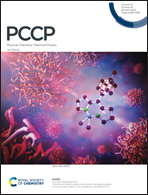Coinage metalides: a new class of excess electron compounds with high stability and large nonlinear optical responses†
Abstract
The possibility of using coinage metal atoms as excess electron acceptors is examined for the first time by designing a new class of M+-1-M′− (M = Li, Na, and K; M′ = Cu, Ag, and Au) compounds termed “coinage metalides” on the basis of an intriguing Janus-type all-cis1,2,3,4,5,6-hexafluorocyclohexane (1) molecule. Under the large facial polarization of 1, the outermost ns1 electrons of alkali metal atoms can be transferred to coinage metal atoms, forming diffuse excess electrons around them. Consequently, the resulting M+-1-Cu− and M+-1-Ag− compounds exhibit significantly large nonlinear optical (NLO) responses. In particular, these novel M+-1-M′− compounds exhibit much higher stability (larger VIEs and Ec values) than that of the corresponding M+·1·M′− (M, M′ = Li, Na, and K) alkalides. We hope this work could open up new possibilities for NLO material design by using coinage metal atoms as excess electron acceptors and, on the other hand, attract more experimental interest and efforts to synthesize such stable compounds in the laboratory.

- This article is part of the themed collection: 2020 PCCP HOT Articles


 Please wait while we load your content...
Please wait while we load your content...